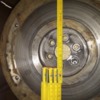After all my clutch problems another Pantera owner has asked me the question, should he have his flywheel skimmed to regain a flat surface again?
He estimates that the flywheel will ned 0.5mm removed to correct the problem.
Will this cause any problems within the very unfriendly clutch system? I know that correct parts and adjustments are paramount and wondered what effect a thinner Flywheel would have.
best Peter
Original Post


